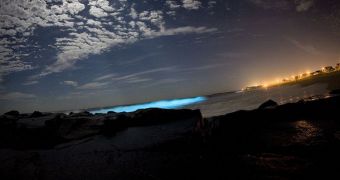Researchers were recently able to confirm one of the most important presuppositions about why certain species of deep-sea microorganisms glow in the dark. Apparently, the bacteria do so because they can then get a free ride to other parts of the ocean, inside the bellies of fish and other marine creatures.
The process of producing light naturally – through chemical reactions inside the body – is called bioluminescence. There are multiple species, both on land and water, that display this trait, but they do it for different reasons. Thus far, little was known about why deep-sea bacteria evolved this ability.
There were, of course, numerous ideas trying to explain the reason why this happens, but no research was until now able to get to the bottom of this mystery. Researchers were recently able to do so in a new set of laboratory experiments.
Israeli and German investigators reveal that bacteria simply use bioluminescence as a method of attracting the attention of large predators. When they are consumed, the microorganisms endure inside the digestive tract of these animals, and get a free ride to wherever the fish that ate them is going.
Details of the study appear in a paper published in the December 27 online issue of the esteemed journal Proceedings of the National Academy of Sciences (PNAS), Science News reports.
“It’s terrific to see this experiment. It’s nice to see these ideas confirmed,” comments Harvard University bioluminescence expert J. Woodland Hastings, who was not a part of the research effort.
Interuniversity Institute for Marine Sciences graduate student Margarita Zarubin, who conducted the research while at the University of Oldenburg, in Germany, started by studying the luminescent Photobacterium leiognathi, which lives about 600 meters (1,970 feet) below the surface of the Red Sea.
In the new experiments, a batch of glowing bacteria was placed at one end of a water tank, and a population of the same species – but genetically modified not to display bioluminescence – at the other. Fish and shrimp were then added to the tank.
Researchers noticed that the animals flocked towards the glowing bacteria, leaving the other batch largely undisturbed. After shrimp ate the bacteria, they too began to glow, which in turn attracted the attention of a cardinalfish.
When they analyzed feces from the cardinalfish, the team noticed that P. leiognathi had passed through the fish's guts without damage, therefore successfully propagating through the water in a very short time frame. Otherwise, the organisms would have needed many generations to cover the same distance.

 14 DAY TRIAL //
14 DAY TRIAL //